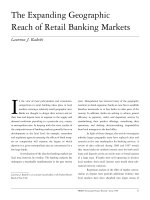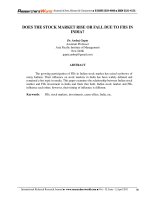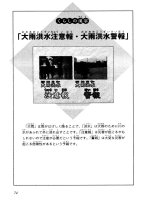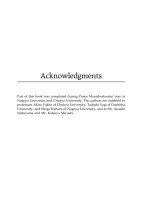The Rise and Fall of Abacus Banking in Japan and China phần 6 ppsx
Bạn đang xem bản rút gọn của tài liệu. Xem và tải ngay bản đầy đủ của tài liệu tại đây (423.54 KB, 17 trang )
Exhibit 4.5
Bank Deposits, Loans, and GDP (1960–1994)
Source: Statistics Bureau, Japan Statistical Association (various years).
84 The Rise and Fall of Abacus Banking in Japan and China
practice, this meant that banks were eventually faced with an ‘‘embar-
rassment of the riches’’: a higher stream of deposits and a lower stream
of loans.
The banks were in a dilemma. Their best customers—big corporations—were not
only walking away from them to raise money on the stock market, they were
also paying back early borrowings. The big firms would then turn around and,
loaded with cash from their stock market dealings, put large amounts of it into
bank accounts. The banks very soon discovered that they were facing an embar-
rassment of the riches on the deposit side of the ledger but a shortage of bor-
rowers to loan the money to on the other.
10
In addition, as more and more internal or equity financing replaced bank
financing, a new institution, ‘‘core banks,’’ replaced the institution of
‘‘main bank.’’ As Shikano puts it,
Banks are losing their competitive advantage against client firms, which have
been supported by the restrictive policy of the Government toward the capital
market, and are required to cope with these challenges. Large firms in Japan are
now trying to designate the top three to five banks as their ‘‘core banks’’ among
banks instead of a single main bank.
11
The replacement of the institution of the main bank with the institution
of the core banks has two important implications for the banking indus-
try. First, banks have become less effective in performing their traditional
function as ‘‘main banks,’’ as brokers in loan syndicates and the risk
diversification associated with it. The decline of the role of the main bank
further means that main banks have become less effective in monitoring
the corporate performance of their clients. Second, as banks turned from
corporate lenders to corporate borrowers, they could no longer perform
their conventional function of imposing fiscal discipline and control over
corporate boards; neither could impose a system of accountability to
stockholders, as is the case in Western market economies. Such a system
simply did not exist.
An important source of discipline—the prudential oversight traditionally exer-
cised by banks over their firms—was lost. Many companies were quite carried
away and raised funds not because they needed them but simply because the
money was so cheap. It was common bubble-economy practice for big corpora-
tions to raise large sums from the stock market at a cost of less than half a percent
and then simply put the money into bank deposits where they earned 6 percent.
12
The Banking Crisis 85
One of the problems with this period is that nobody asked the stockholders what
they thought, and nobody cared. During these years banks lost their traditional
oversight function because firms no longer needed them. Yet the system of ac-
countability to stockholders that operates in the United States and other markets
had not been developed.
13
With little accountability to their stockholders, freed from the bank
discipline, and with easy money raised in the equity and debt markets,
zeitek turned into a reckless expansion of productive capacity, especially
in the early 1990s, when operation rates declined substantially (see Ex-
hibit 4.6). Zeitek further engaged corporations into an acquisition spree
in the West, especially in the United States. Many of the most precious
U.S. assets—record labels and movie studios, theme parks, technology
companies, and hotel and ski resorts—including CBS Records, Columbia
Pictures, MCA, and Rockefeller Center—came under Japanese owner-
ship.
The interest of Japanese corporations in American assets was not just
confined to corporate acquisitions; it extended to portfolio and real estate
investments, U.S. corporate stocks, government securities, and real es-
tate. As of 1989, Japanese had invested the cumulative total of about
$300 billion in the U.S. economy. According to estimates reported in
Tokyo Business Today, Japanese companies purchased $13 billion worth
of equity in 1990. Throughout the 1980s, the Japanese financed about
one-third of the U.S. government deficit. By 1989, Japanese investments
in real estate had reached $14.8 billion.
It did not take long before the speculative mania that swept the land
and real estate markets spread over to the equity markets and to every
object of speculation. Rising asset values fed into this frenzy, a mob psy-
chology where investors rushed to buy assets not because of their fun-
damental values but because of the potential of quick appreciation, or
by imitating others who had become rich that way. According to Kin-
dleberger,
Mob psychology or hysteria is well established as an occasional deviation from
rational behavior. We have its elements in many economic models: the demon-
stration effect, which leads developing countries to adopt consumption standards
beyond their capacity to produce for themselves; keeping up with Joneses in
consumption; refusing, when income declines, to cut consumption systematically
with the increase in consumption that occurred when income rose (the Duesen-
berry effect).
14
Exhibit 4.6
Production Capacity and Operating Rate (1981–1996)
Source: Statistics Bureau, Japan Statistical Association (various years).
The Banking Crisis 87
In short, excess liquidity and deregulation provided both the funds
and the incentive, while jusen provided the vehicle that allowed Japanese
executives, real estate brokers, investment bankers, and yakuza (organ-
ized crime members) to engage in a speculative mania comparable to
the Dutch tulip mania of the seventeenth century and the South Sea
mania of the eighteenth century, mentioned earlier in this chapter. And
as was the case with previous manias, investors and the bankers who
financed them ignored almost every principle of risk management. First,
they ignored the direct relationship between risk and interest rate pre-
mium (i.e., the riskier the investment, the higher the interest rate pre-
mium). Ignoring this principle, Japanese investors valued assets not in
relation to economic fundamentals, such as the prospective returns and
appreciation potential of an asset, but in relation to other already over-
valued assets. Foreign and domestic equities, real estate, and even fine
art were compared to already overvalued Tokyo real estate prices. How
else could one explain and justify the astronomical prices Japanese in-
vestors paid for fine art and foreign real estate? In 1989, for instance,
Tomonori Tsurumaki, the Japanese real estate broker, paid $51.7 million
for Picasso’s ‘‘Les Noces de Pierrette’’ and $400 million for a resort in
Southern Japan. In 1990, Ryoei Saito, the owner of a large manufacturing
firm, paid $82.5 million for van Gogh’s ‘‘Portrait of Dr. Gachet’’ and
another $78.1 million for Renoir’s ‘‘Le Moulin de la Galette.’’ In 1989, the
Sazale Group paid $110 million—a record of $1.2 million per room—for
the Bel-Air Hotel.
15
Real estate companies, jusen, housing-loan corpora-
tions, and credit cooperatives lent yakuza billions of dollars in the 1980s.
16
Japanese collectors paid a record $40 million for Vincent van Gogh’s
‘‘Sunflowers.’’ Mitsui Real Estate overpaid $235 billion for the Exxon
building,
17
and Mitsubishi Real Estate paid $850 million for New York’s
Rockefeller Center.
Second, taken by a herd mentality, Japanese investors and the banks
that financed them ignored another principle of risk management, di-
versification (the spread of an investment portfolio over several projects
and regions). Japanese banks and other credit institutions, for instance,
limited their lending to a few individuals and institutions. Tokyo-Kyowa,
for instance, lent $376 million (or 40 percent of the institution’s total
outstanding loans) to a Mr. Takahashi, an entrepreneur with cozy ties
with MOF officials. Credit co-ops did even worse than that; close to 40
percent of them extended large loans to single clients, illegally!
18
Japa-
nese banks further concentrated their financing activities in a few geo-
graphic areas, such as California and Hawaii. ‘‘Rather than fanning
88 The Rise and Fall of Abacus Banking in Japan and China
Exhibit 4.7
Purchase versus Sale Value of Selected Japanese Investments
across the United States, Japanese commercial banks have clustered their
operations in California, where five are now among the ten biggest, and
20 percent of all bank assets are now Japanese owned.’’
19
Japan’s in-
vestment in real estate is particularly evident in Hawaii, where the Jap-
anese have invested $1.9 billion, a figure that represents close to 70
percent of foreign investment in the island.
20
As confirmation of this herd
mentality and concentration, Japanese banks commanded the same in-
vestment grading. ‘‘The propensity of the Japanese to act in objective
concert can be seen all over the map. Following roughly similar policies,
Japanese commercial banks have ended up with roughly similar inter-
national credit ratings, and many of them are tops—AAA.’’
21
Unfortunately for Japanese investors and their financiers, the nation’s
banks, and jusen, easy money did not last forever. Neither did robust
economic growth and rising asset prices. As the art market declined
along with real estate prices, Japanese banks found themselves with re-
possessed paintings and with real estate properties that could fetch only
a fraction of the amount the banks had lent to their previous owners (see
Exhibit 4.7). By 1995, many Japanese companies were divesting part or
all of their early acquisitions, including Matsushita Corporation, which
sold 80 percent of its holdings in MCA for $5.7 billion, taking a huge
loss in yen terms, and Rockefeller Center, which had gone bankrupt.
22
To make matters worse, the yen appreciation and the collapse of the
Tokyo real estate market undermined banks’ domestic and international
equity holdings. In fact, every time the Nikkei stock average drops, it
has a significant negative effect on banks’ balance sheets. A decline in
the Nikkei from 19,563 to 15,000 cuts Asahi Bank’s profit from $1,052 to
$430 and the Bank of Tokyo’s from $599 to $110 (see Exhibit 4.8). In fact,
Exhibit 4.8
Banks’ Latent Profits
Source: Adapted from Nomura Research Institute.
90 The Rise and Fall of Abacus Banking in Japan and China
as banks strove to survive on interest income, they accelerated their reck-
less lending, accumulating additional non-performing assets.
23
Even as
recently as 1996, at least half of the 21 major Japanese banks reported
losses due to write-offs of bad loans, with the remaining following suit
shortly thereafter.
24
In short, Japan’s banking crisis can be attributed to a combination of
factors—the hyperliquidity that provided the fuel, the deregulation that
provided the incentive, and the introduction of jusen that provided the
vehicles for turning hyperliquidity into non-performing assets. But is this
not similar to the U.S. savings and loans crisis of the 1980s? In a sense,
it is. In both countries, the banking crisis can be attributed to a combi-
nation of high-risk investment ventures, overoptimism, and poor risk
management. According to White,
The bulk of the insolvent thrifts’ problems, however, did not stem from such
fraudulent or criminal activities. These thrifts largely failed because of an amal-
gam of deliberately high-risk strategies, poor business judgements, foolish strat-
egies, excessive optimism, and sloppy and careless underwriting, compounded
by deteriorating real estate markets.
25
Yet the banking crisis in the two countries differs in four ways. First,
U.S. thrifts have been more experienced in handling financial crises. Spe-
cifically, U.S. thrifts had faced similar conditions in the late 1960s during
the Vietnam War, when rising inflation pushed deposit interest rates
higher, hurting bank profitability. Second, having made early strides in
deregulation, U.S. banks were more diversified in terms of products and
services supplied than Japanese banks. In 1994, for instance, loans ac-
counted for around 58 percent of total assets, compared to 65 percent in
Japan (see Exhibits 4.9 and 4.10). Third, in the United States, regulation
rarely restricted bank managers’ freedom to make decisions. Fourth, in
contrast to Japanese banks, U.S. banks were much smaller, which made
them more flexible in dealing with the rapid changes in their market
environment brought about by deregulation. But why did the MOF and
the BOJ fail to diagnose the bubble and take measures to burst it earlier,
rather than later?
The MOF failed to diagnose the bubble and the banking crisis because
it was part of the problem rather than part of the solution. In fact, as
early as 1992, the MOF knew that some jusen were already in trouble,
but the cozy ties with the institutions they were supposed to oversee
prevented them from taking prompt and diligent action. ‘‘Jusen docu-
Exhibit 4.9
Bank Net Loans in Japan (1960–1996) (percent of total assets)
Exhibit 4.10
Bank Net Loans in the United States (1980–1995) (percent of total assets)
The Banking Crisis 93
ments released recently show that the ministry’s Banking Bureau has
been dysfunctional. The ministry knew that the jusen were on the brink
of bankruptcy back in 1992, but decided to take no action.’’
26
In some
cases, such as that of Daiwa’s subsidiary in the United States, Japanese
regulators asked Japanese officials to bogai, or conceal losses from the
U.S. regulators because MOF officials placed their own interests ahead
of the general public that they were supposed to protect; but there was
a good reason for that—amakundori, or ‘‘descent from heaven.’’
Upon retirement, amakundori allows former bureaucrats with the MOF
to be employed by the institutions they used to regulate. But even before
they get there, even when they discharge their normal duties as regu-
lators, they frequently socialize with bank executives, accepting generous
gifts. According to Williams,
As Japan’s banks were lending promiscuously to real-estate speculators, golf-
course builders and gangsters in the late 1980s and early 1990s, an elite group
of former bureaucrats was in a position to act. At that time, some of today’s
ailing lenders had Finance Ministry and Bank of Japan alumni in crucial jobs as
auditors, directors, executives, and presidents.
27
But why did the BOJ fail to diagnose the economic bubble and take
preemptive measures to burst it? The BOJ failed to diagnose the bubble
because of its belief of a ‘‘New Era’’ for the Japanese economy, a supply
side–driven expansion without the threat of inflation, as suggested by
the traditional Phillips inflation-unemployment trade-off. Specifically,
though Japan’s economy unemployment rate fell to levels below what is
considered a ‘‘natural rate,’’ the BOJ did not expect a relapse of inflation,
and for good reason (see Exhibit 4.11). Due to the rising yen, falling
import prices, and rising productivity, a decline in the unemployment
rate did not translate into higher but into lower inflation (see Exhibits
4.12 and 4.13).
In short, during the bubble years, having found themselves with excess
liquidity, Japanese banks either directly or indirectly through the jusen
extended credit to Gene-con and other investors based on inflated bubble
values rather than on economic fundamentals. So when the bubble burst,
banks were left with non-performing assets. In this sense, the Japanese
banking crisis was the result of the failure of the Japanese system as a
whole rather than the failure of individual banks, as was the case with
the savings and loans crisis in the United States in the 1980s. Nurtured
in an environment of fast economic growth, keiretsu relations, and tight
Exhibit 4.11
Unemployment Rate (1975–1996)
Source: Statistics Bureau, Japan Statistical Association (various years).
Exhibit 4.12
Japan’s Domestic Wholesale Price Index (1981–1996)
Source: Statistics Bureau, Japan Statistical Association (various years).
Exhibit 4.13
Japan’s Labor Productivity (1960–1996)
Source: Statistics Bureau, Japan Statistical Association (various years).
The Banking Crisis 97
government regulation, Japanese bankers lacked the ability, the incen-
tives, and the skills to manage funds in a risky environment.
A cause and a symptom of the economic stagnation, the banking crisis
has crippled the ability of the monetary authorities to stimulate the econ-
omy out of the stagnation, but it has seriously damaged their reputation.
With many MOF and BOJ officials involved in bank scandals, the Japa-
nese public’s trust and faith in bureaucracy has been seriously shaken,
paving the way for a new government structure that shifts power away
from appointed bureaucrats to elected politicians. And that is also true
for Chinese banks, an issue that will be further addressed in the second
part of this book.
NOTES
1. M. Hulbert, ‘‘There Is a Price to Pay for Ignoring Risk,’’ New York Times,
December 6, 1998, p. 6.
2. R. Sobel, ‘‘Going to Extremes,’’ Barron’s, January 2, 1999.
3. Estimating the size of the banking crisis is rather difficult due to poor
disclosure requirements.
4. For a detailed discussion of manias and panics, see Kindleberger (1989).
5. Hartcher (1998), pp. 155–156.
6. In fact, agricultural credit institutions contributed 45 percent of jusen funds.
For details, see OECD (1995), p. 51.
7. Burstein (1988), p. 44.
8. For details, see OECD, Economic Outlook (Paris: OECD, 1990/1991), p. 89.
9. OECD, 1991 Annual Survey (Paris: OECD, 1991), p. 98.
10. Hartcher (1998), p. 74.
11. Shikano (1998), p. 93.
12. Hartcher (1998), p. 71.
13. Ibid., p. 73.
14. Kindleberger (1989).
15. Powell and Takayama (1992).
16. ‘‘How the Mob Burned the Banks’’ (1996).
17. Hartcher (1998), p. 71.
18. Ibid., p. 135.
19. Burstein (1988), p. 216.
20. J. Larson, ‘‘Japanese Invasion Welcomed in Hawaii,’’ American Demograph-
ics, Vol. 13, No. 12 (December 1991).
21. Burstein (1988), p. 216.
22. Mitchell (1997), p. 5.
23. Ibid.
98 The Rise and Fall of Abacus Banking in Japan and China
24. Sapsford (1996b).
25. White (1991), p. 117.
26. ‘‘Loan Crisis Makes Clear’’ (1996b).
27. Williams (1996), p. 1.
Part II
The Rise and Fall of Abacus
Banking and the Looming
Banking Crisis in China









